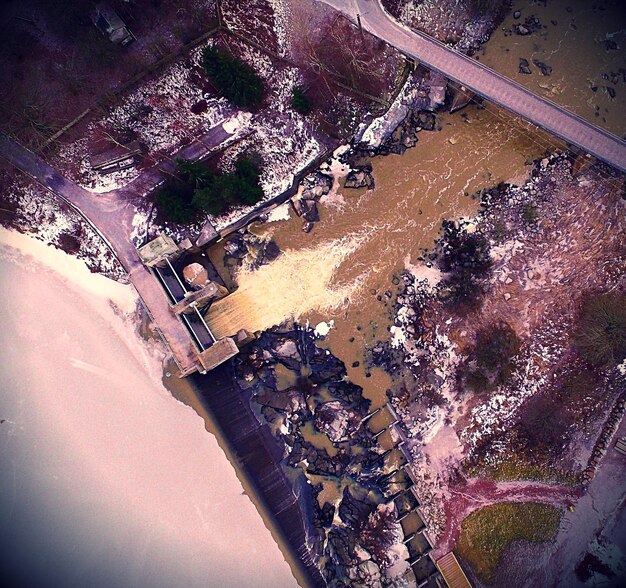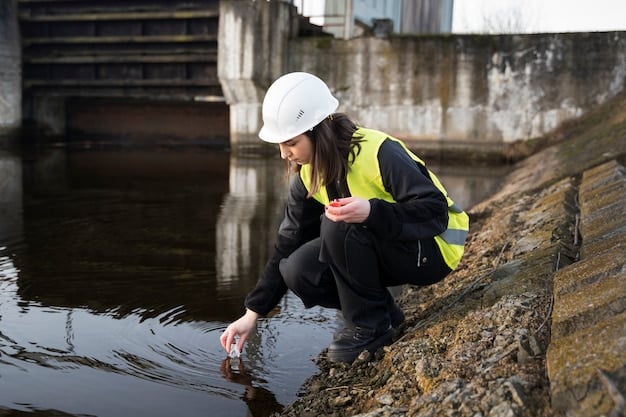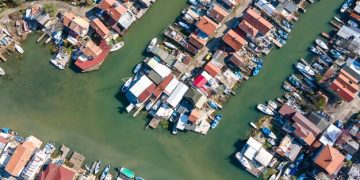US Infrastructure Climate Adaptation Costs by 2030: Projections & Impact

The projected costs for adapting US infrastructure to climate change impacts by 2030 are estimated to be in the hundreds of billions to trillions of dollars, encompassing vital sectors such as transportation, energy, water, and coastal defense, reflecting the escalating financial burden of climate inaction and the urgent need for proactive investment.
The stark reality of climate change looms large over the United States, threatening not just environmental stability but the very foundations of its economic and societal framework. When we ask, What are the Projected Costs of Adapting US Infrastructure to the Impacts of Climate Change by 2030?, we delve into a complex, multifaceted challenge with staggering financial implications. This isn’t merely about dollars and cents; it’s about resilience, sustainability, and the long-term well-being of a nation.
Understanding the Climate Challenge for US Infrastructure
The United States’ infrastructure, a vast network supporting daily life and commerce, faces unprecedented threats from a changing climate. Rising sea levels, more frequent and intense storms, extreme heat, and prolonged droughts are not abstract predictions; they are current realities inflicting tangible damage. Assessing these vulnerabilities is the first critical step in quantifying the immense task ahead.
From coastal communities bracing for storm surges to inland areas grappling with drought and wildfires, every region feels the distinct pressure of climate shifts. The interconnectedness of infrastructure means a failure in one sector can cascade, creating widespread disruptions and amplifying economic losses. Understanding these localized impacts is key to developing tailored, effective adaptation strategies.
The Interconnectedness of Infrastructure Vulnerabilities
Climate change does not affect infrastructure in isolation. A power outage due to extreme heat can cripple water treatment plants, leading to public health crises. Flooded roads compromise emergency services and supply chains. This intricate web necessitates a holistic approach to adaptation, considering the domino effect of climate impacts. The financial estimates must account for this synergistic vulnerability.
- Energy Grids: Vulnerable to extreme heat (overload/buckling lines), severe storms (downed lines), and wildfires.
- Transportation Networks: Roads and bridges susceptible to flooding, heat-induced pavement buckling, and permafrost thaw.
- Water Systems: Threatened by drought (supply scarcity) and intense rainfall (overwhelmed drainage, contamination).
- Coastal Defenses: At risk from sea-level rise, storm surges, and coastal erosion, impacting homes and businesses.
Data Sources and Methodologies for Cost Projections
Calculating the projected costs of climate adaptation is a monumental undertaking, drawing on a diverse array of data sources and sophisticated economic modeling. Researchers and governmental agencies utilize historical damage data, climate projections, engineering assessments, and cost-benefit analyses to arrive at these complex figures. The methodologies often vary, leading to a range of estimates, but all point to astronomical sums.
Leading institutions like the Government Accountability Office (GAO), the American Society of Civil Engineers (ASCE), and academic research centers employ different models, often incorporating factors such as population density, specific infrastructure assets, and projected climate scenarios. The figures discussed are not static; they evolve as climate science improves and as more detailed localized assessments become available, aiming for greater precision in these critical projections.
Ultimately, the costs discussed here represent the investment required to build a more resilient nation, capable of withstanding the inevitable impacts of a changing climate. Proactive adaptation is not just an environmental imperative; it is an economic necessity, protecting lives, livelihoods, and the functionality of American society.

Major Infrastructure Sectors and Their Adaptation Costs
Adapting the vast and varied infrastructure of the United States to climate change involves targeted interventions across multiple critical sectors. Each sector faces unique challenges and requires specific, often costly, solutions. Understanding these sector-specific projections helps to break down the daunting overall figures into more manageable components, highlighting where urgency and investment are most critical.
Transportation Networks: Roads, Bridges, and Ports
The nation’s transportation arteries – its roads, bridges, railways, and ports – are profoundly vulnerable to climate impacts. Rising temperatures cause asphalt to degrade; heavier rainfall leads to widespread flooding and bridge scour; and sea-level rise threatens coastal infrastructure and major shipping hubs. The costs for adaptation in this sector include elevating roads, reinforcing bridge structures, improving drainage systems, and building new sea walls to protect port facilities.
Estimates for transportation infrastructure adaptation alone routinely run into the tens to hundreds of billions of dollars. For instance, the Federal Highway Administration has highlighted the need for significant investment in climate-resilient roads and bridges. Moreover, the long lifespan of these assets means that investments made now will affect resilience for decades to come, making these expenditures critical for future economic stability.
Energy Infrastructure: Grids, Power Plants, and Pipelines
The energy sector is at the forefront of climate vulnerability due to its widespread nature and sensitivity to extreme weather. Heatwaves can strain power grids, leading to blackouts, while severe storms can devastate transmission lines and power plants. Wildfires, often exacerbated by drought and high temperatures, pose an immense threat to energy assets, particularly in western states. Adaptation strategies involve hardening transmission lines, undergrounding critical components, developing smart grids for better load management during extreme events, and relocating vulnerable facilities.
- Grid Modernization: Investing in smart grid technologies to better manage demand and supply during peak heat or cold events.
- Physical Hardening: Strengthening power poles, insulating substations, and improving vegetation management near power lines.
- Relocation/Protection: Moving critical energy infrastructure away from floodplains or coastal zones, or building robust flood defenses around them.
- Renewable Integration: While not solely adaptation, integrating diverse, decentralized renewable energy sources can enhance overall grid resilience.
Water Resource Management: Supply, Quality, and Flood Control
Water infrastructure, encompassing everything from reservoirs and treatment plants to levees and storm drains, is central to public health and economic activity. Climate change impacts water availability through prolonged droughts, while intense rainfall events overwhelm existing drainage systems, leading to urban flooding and water quality issues. Adaptation in this sector focuses on improving water conservation, expanding water storage capacity, upgrading stormwater management systems, and repairing or replacing aging pipes to reduce leakage.
The costs for water resource adaptation are substantial, including investments in resilient water supplies, advanced water treatment technologies to handle varying raw water quality, and large-scale flood control projects. The infrastructure here is not just about moving water; it’s about ensuring its purity and consistent availability, both of which are under increasing stress from climate variability.
Coastal and Port Infrastructure: Defending Against Sea-Level Rise
The heavily populated and economically vital coastal regions of the US are particularly susceptible to the impacts of sea-level rise and increased storm intensity. Ports, naval bases, and critical coastal communities are directly in the path of these changes. Adaptation measures include building higher and stronger sea walls, restoring natural protective barriers like wetlands and dunes, and elevating at-risk structures. Retreat from certain highly vulnerable areas is also a consideration, although often highly contentious and costly.
The expenditures in coastal defense are among the highest in infrastructure adaptation. The concentration of economic activity and population in these areas means that failures can lead to catastrophic losses. Projections suggest that protecting coastal assets will require hundreds of billions of dollars by 2030, a figure that continues to climb as sea-level rise accelerates.
These sector-specific costs aggregate to a massive national challenge, highlighting the interconnected nature of adaptation efforts and the strategic importance of early, coordinated investment. Each dollar spent today on proactive measures can potentially save many more in future disaster recovery and reconstruction.
The Range of Cost Projections: Billions to Trillions
The question of “how much” is inherently complex due to varying methodologies, time horizons, and assumptions about future climate scenarios. While there isn’t a single, universally agreed-upon figure, the consensus among experts is that the projected costs for adapting US infrastructure to climate change by 2030 will be in the hundreds of billions to potentially trillions of dollars. This wide range reflects the inherent uncertainties and the scope of what is considered “adaptation.”
Influencing Factors in Cost Variability
Several factors contribute to the wide range in cost projections. One major factor is the severity of future climate impacts – whether global warming trends align with more moderate or more extreme scenarios. Another is the chosen level of protection: are we aiming for minimal resilience, or a “gold standard” of protection against worst-case scenarios? The timeframe also matters; our focus on 2030 provides a near-term snapshot, but the longer-term outlook pushes figures even higher.
- Climate Severity: Differences in global emissions trajectories and regional climate model outputs.
- Adaptation Level: Whether solutions are incremental or transformative, aiming for full protection or managed retreat.
- Discount Rates: How future costs are valued today, influencing the net present value of projects.
- Technological Advancements: Potential for new, more cost-effective solutions to emerge.
- Economic Assumptions: Future growth, inflation, and construction costs.
Key Reports and Their Estimates
Various influential reports provide different perspectives on these costs. For example, the American Society of Civil Engineers (ASCE) has consistently highlighted a significant “infrastructure gap,” a portion of which is directly attributable to climate resilience needs. Their reports, while not always isolating a 2030 figure, cumulatively project costs of hundreds of billions for the most vulnerable sectors over coming decades.
Other analyses, like those from the Government Accountability Office (GAO) and academic institutions, often echo these concerns, sometimes providing more granulated projections for specific sectors or regions. For instance, reports focusing solely on coastal defense cite figures well into the hundreds of billions just for protecting existing assets. The common thread across these diverse reports is the unequivocal message: the costs are substantial and growing, and proactive investment is far more cost-effective than reactive recovery.
The Cost of Inaction: A Higher Price Tag
Crucially, the projected costs of adaptation must be viewed against the far greater costs of inaction. Delayed or insufficient adaptation would lead to escalating economic damages from climate-related disasters, loss of life, reduced productivity, and significant disruption to supply chains and essential services. Estimates from various sources, including the National Institute of Building Sciences, consistently show that every dollar invested in hazard mitigation saves, on average, six dollars in future losses.
This “cost of inaction” includes not only the direct damage to infrastructure but also the broader economic ripple effects, such as business interruptions, decreased property values, and increased insurance premiums. It is the understanding of this “cost-effectiveness of adaptation” that drives the urgency behind current projections and policy discussions.
While the exact figures remain fluid, the directional consensus is clear: the costs are immense, but the benefits of investing in a resilient future far outweigh the consequences of allowing climate impacts to erode the nation’s foundational systems without adequate preparation.
Economic and Social Implications of Adaptation Costs
The immense financial outlays associated with adapting US infrastructure to climate change have far-reaching economic and social implications. These costs are not merely line items on a budget; they represent significant shifts in public and private spending, potential impacts on economic growth, and fundamental questions of equity and shared responsibility. The way these costs are borne and managed will shape the nation’s future.
Impact on National and Local Economies
Funding climate adaptation will necessitate significant allocation of resources from both federal and state budgets, as well as private sector investment. This could affect priorities in other areas of public spending. However, the spending also represents an economic stimulus, creating jobs in engineering, construction, and related fields. The challenge lies in ensuring these investments are strategically deployed to maximize both resilience and economic return.
At the local level, communities, particularly those most vulnerable to climate impacts, may face increased tax burdens or struggles to secure funding for critical projects. Disparities in economic capacity among local governments could exacerbate existing inequalities, making federal support and streamlined funding mechanisms crucial. The economic vitality of entire regions could hinge on their ability to adapt effectively.
Funding Mechanisms and Public-Private Partnerships
Financing adaptation will require diverse funding streams beyond traditional public works appropriations. Mechanisms such as climate bonds, resilience funds, and innovative public-private partnerships are being explored and implemented. Private sector investment is increasingly seen as essential, given the scale of the challenge and the potential for new markets in resilient infrastructure technologies and services.
Incentivizing private investment through tax credits, grants, and risk-sharing agreements could unlock significant capital. However, ensuring equitable access to these funds and preventing the concentration of benefits in wealthier areas will be critical. The federal government will likely play a central role in coordinating these efforts and providing foundational funding, particularly for projects with national significance.
Equity and Social Justice Considerations
The distribution of climate change impacts and adaptation costs is not uniform. Historically marginalized and low-income communities often face disproportionately higher risks from climate disasters due to location, inadequate infrastructure, and limited resources for recovery. Ensuring that adaptation strategies prioritize these vulnerable communities and that the burden of costs does not fall unfairly upon them is a profound social justice issue.
Policies must be designed to build resilience in these communities, providing resources for flood protection, heat mitigation, and access to critical services. This includes ensuring fair housing, promoting community-led adaptation initiatives, and considering managed retreat as a respectful option when necessary, with appropriate support for relocation and resettlement. A just transition to a climate-resilient future demands that adaptation benefits everyone, not just those with the means to protect themselves.
The economic and social implications of climate adaptation are complex, extending far beyond initial cost estimates. They touch upon issues of economic growth, fiscal policy, intergovernmental relations, and fundamental fairness. Navigating these challenges effectively will be paramount to building a resilient and equitable future for all Americans.
Challenges and Innovations in Adaptation Planning
Adapting US infrastructure to the reality of a changing climate is not merely an engineering problem; it’s a monumental planning challenge fraught with complexities and uncertainties. However, alongside these challenges, there’s a growing wave of innovation, offering new tools, materials, and approaches to build a more resilient future. The intersection of these forces will define the pace and effectiveness of adaptation efforts.
Uncertainties in Climate Projections and Local Impacts
Despite significant advancements in climate science, localized climate projections for 2030 and beyond still carry degrees of uncertainty. Predicting the precise timing and intensity of extreme weather events at a micro-level, or the exact rate of sea-level rise in a specific bay, remains challenging. This uncertainty can complicate engineering design and investment decisions, as stakeholders grapple with balancing cost-efficiency against the need for robust protection for a range of possible future scenarios.
- Regional Variability: Climate impacts differ significantly across the vast geography of the US, requiring localized data.
- Predictive Models: Continuously evolving models offer better resolution but still carry inherent probabilistic ranges.
- Adaptive Planning: Embracing “adaptive pathways” that allow for adjustments based on new data rather than fixed, rigid plans.
Overcoming Regulatory and Bureaucratic Hurdles
The multi-jurisdictional nature of infrastructure, often involving federal, state, and local agencies, can create bureaucratic hurdles for integrated adaptation planning. Permitting processes, differing design standards, and a lack of coordinated governance across various levels can slow down critical projects. Streamlining these processes, fostering interagency collaboration, and developing consistent, performance-based standards are crucial to accelerate adaptation efforts, particularly those spanning multiple political boundaries.
Furthermore, outdated building codes and zoning regulations may not adequately account for future climate risks. Updating these regulations to incorporate climate resilience as a core criterion is a slow but essential process that requires political will and public education. Overcoming these systemic challenges is as critical as overcoming scientific or engineering ones.
Technological Advances and Nature-Based Solutions
Innovation is rapidly transforming the landscape of climate adaptation. Advances in materials science are leading to more durable, climate-resistant construction materials. Data analytics and artificial intelligence are improving predictive modeling for storm surges and flood risks, enabling smarter infrastructure design. Sensor technologies allow for real-time monitoring of infrastructure health, facilitating proactive maintenance and repairs.
Equally important are nature-based solutions, which leverage natural systems for protection. Restoring wetlands, planting mangroves, and creating living shorelines can provide cost-effective and ecologically beneficial defenses against coastal erosion and flooding. These solutions often offer co-benefits, such as improved biodiversity and recreational opportunities, and are increasingly integrated into comprehensive adaptation plans, providing a sustainable alternative or complement to traditional “grey” infrastructure.
The path to a climate-resilient US infrastructure by 2030 is paved with significant challenges, but it is also illuminated by groundbreaking research and innovative solutions. A proactive, collaborative, and adaptable approach will be essential to navigate this complex terrain.
Policy and Investment Strategies for 2030
Meeting the challenge of climate adaptation by 2030 requires robust and forward-looking policy and investment strategies. It’s not enough to simply identify the costs; there must be concrete plans for financing, implementing, and governing these crucial efforts. The effectiveness of these strategies will largely determine whether the US can build resilient infrastructure in time to mitigate the most severe climate impacts.
Federal and State Government Roles
Federal leadership is pivotal, setting national adaptation goals, providing significant funding through dedicated programs, and establishing technical guidelines. Existing initiatives, such as the Bipartisan Infrastructure Law, have already allocated substantial funds for resilience projects, though more will be needed. Federal agencies like FEMA, EPA, and DOT are crucial in distributing funds, offering technical assistance, and developing climate-informed planning tools for states and localities.
State governments also play a critical role, tailoring federal guidelines to local contexts, coordinating regional efforts, and often providing matching funds for projects. Many states are developing their own climate action plans and creating offices specifically dedicated to climate resilience, recognizing the urgency and localized nature of the threat. The collaboration between these levels of government is paramount for cohesive and effective action.
Prioritizing Investments and Adaptive Planning
Given the immense costs, strategic prioritization is essential. Investing in critical infrastructure — such as essential transportation routes, major utility systems, and facilities vital for public safety — is paramount. A risk-based approach, focusing on areas and assets with the highest vulnerability and greatest potential for cascading failures, can optimize resource allocation. This involves rigorous vulnerability assessments and cost-benefit analyses for proposed projects.
Furthermore, adaptive planning, which embraces flexibility and adjusts to new climate data, is becoming a standard. Instead of building for a single future projection, infrastructure projects are designed with “flex points” that allow for upgrades or modifications as climate conditions evolve. This approach acknowledges uncertainty while ensuring readiness, making early investments more robust against future changes.
Incentivizing Private Sector Engagement
The private sector holds vast capital and expertise essential for climate adaptation. Governments can incentivize private investment through various mechanisms: tax credits for resilient construction, low-interest loans for climate-proofing businesses, and public-private partnership models that share risks and rewards. Clear regulatory frameworks and long-term policy signals are vital to give businesses the confidence to invest in climate-resilient solutions and technologies.
The insurance industry also has a growing role, both in assessing climate risks and in driving resilient building practices through their policies and premiums. Encouraging innovative financial instruments, such as resilience bonds or catastrophe bonds, can further mobilize private capital for large-scale adaptation projects. Harnessing the power of the market can significantly accelerate the pace of adaptation.
By 2030, the success of US infrastructure adaptation will hinge on a combination of strong governmental commitment, strategic investment prioritization, and robust engagement with the private sector. These intertwined elements form the backbone of a comprehensive strategy for a resilient future.
Future Outlook and Beyond 2030
While the focus on 2030 provides a critical short-term benchmark for climate adaptation costs, the impacts of climate change will extend far beyond this decade. The efforts undertaken by 2030 will lay the groundwork for long-term resilience, shaping the economic and ecological landscape of the United States for generations. Understanding this broader horizon is crucial for sustained planning and investment.
Long-Term Climate Trends and Adaptation Needs
Climate models indicate that even with aggressive emissions reductions, certain impacts like sea-level rise and increased extreme weather events will continue to intensify beyond 2030. This means that adaptation is not a one-time fix but an ongoing, iterative process. Infrastructure designed today must anticipate these long-term trends, requiring adaptive capacity and future-proofing in its construction.
The trajectory of global warming will heavily influence the scale of future adaptation needs. Lower emissions scenarios would lead to more manageable costs and less severe impacts, whereas higher emissions would necessitate increasingly drastic and expensive adaptation measures. The connection between mitigation (reducing emissions) and adaptation is therefore profound: successful mitigation lowers the long-term adaptation burden.
Integration of Adaptation into Routine Planning
For adaptation to be truly effective, it must transition from being an emergency response to an integral part of routine infrastructure planning and decision-making. This means considering climate risks in every new construction project, every repair, and every zoning update. Integrating climate resilience into engineering standards, zoning codes, and professional training programs will embed these considerations at the foundational level of infrastructure development.
This systematic integration ensures that adaptation becomes a continuous process rather than a standalone endeavor, fostering a culture of climate-ready development. It also helps to avoid maladaptation, where investments made today might inadvertently increase vulnerability in the future due to unforeseen climate impacts.
The Role of Resilient Communities
Beyond physical infrastructure, the resilience of communities themselves is paramount. This includes social networks, local economies, and public health systems that can absorb and recover from climate shocks. Investments in community preparedness, early warning systems, and post-disaster recovery mechanisms complement physical infrastructure adaptation, creating a more robust defense against climate impacts. Empowering local communities to lead their own adaptation planning, supported by resources and technical expertise, is key to building a truly resilient nation.
The journey towards full climate adaptation is long and complex, extending well beyond the 2030 horizon. The costs projected for the coming decade are merely the initial investment in a long-term commitment. By embracing continuous innovation, strategic policy shifts, and a holistic approach that integrates infrastructure with community resilience, the US can navigate the challenges of a changing climate and build a more secure future.
| Key Aspect | Brief Description |
|---|---|
| 📊 Cost Range by 2030 | Hundreds of billions to trillions of USD. Reflects varying climate scenarios and adaptation levels. |
| 🏗️ Key Sectors Affected | Transportation, energy, water management, coastal and port infrastructure. Each needs specialized solutions. |
| 💰 Cost of Inaction | Significantly higher than proactive adaptation, including economic losses and societal disruption. |
| 💡 Innovations & Policies | New technologies, nature-based solutions, and strategic federal/state partnerships are crucial for effective adaptation. |
Frequently Asked Questions About US Infrastructure Climate Adaptation Costs
▼
The cost projections vary due to several factors, including the specific climate scenarios considered (moderate vs. extreme), the level of protection desired (minimal vs. comprehensive), the methodologies used for economic modeling, and assumptions about technological advancements and future material costs. Each study uses different inputs, leading to a broad range of estimates.
▼
The sectors facing the highest adaptation costs typically include coastal infrastructure (due to sea-level rise and storm surges), transportation networks (roads, bridges, railways susceptible to flooding and heat), and energy grids (vulnerable to extreme temperatures and severe storms). Water resource management, addressing both drought and intense rainfall, also incurs significant expenses.
▼
Numerous studies, including those by the National Institute of Building Sciences, consistently show that proactive climate adaptation is significantly more cost-effective than reactive disaster recovery. Generally, every dollar invested in hazard mitigation saves an estimated six dollars in future losses, making early investment a sound economic strategy to minimize long-term damages and disruptions.
▼
Funding for climate adaptation is expected to come from a mix of sources. This includes direct federal and state appropriations (e.g., through infrastructure bills), grants, loans, and increasingly, public-private partnerships. Innovative financial instruments like green bonds and resilience funds are also being explored, alongside efforts to incentivize private sector investment in resilient technologies and construction.
▼
Technology offers solutions like advanced climate modeling, durable materials, and smart infrastructure systems, potentially making adaptation efforts more efficient. Nature-based solutions, such as restoring wetlands and building living shorelines, can be cost-effective alternatives or complements to traditional grey infrastructure, providing ecological benefits while enhancing resilience and potentially reducing overall costs.
Conclusion
The projected costs of adapting US infrastructure to the impacts of climate change by 2030 represent an undeniable and substantial financial challenge, ranging from hundreds of billions to trillions of dollars. These figures underscore the urgent need for strategic, comprehensive, and equitable investment across all critical sectors, from transportation and energy to water resources and coastal defenses. While the task is daunting, the costs of inaction—in terms of economic damage, societal disruption, and human well-being—are demonstrably far greater than the proactive investments required. By embracing innovative solutions, fostering robust public-private partnerships, and integrating climate resilience into every facet of planning and development, the United States can build a more secure, adaptable, and resilient future for its infrastructure and its people.





